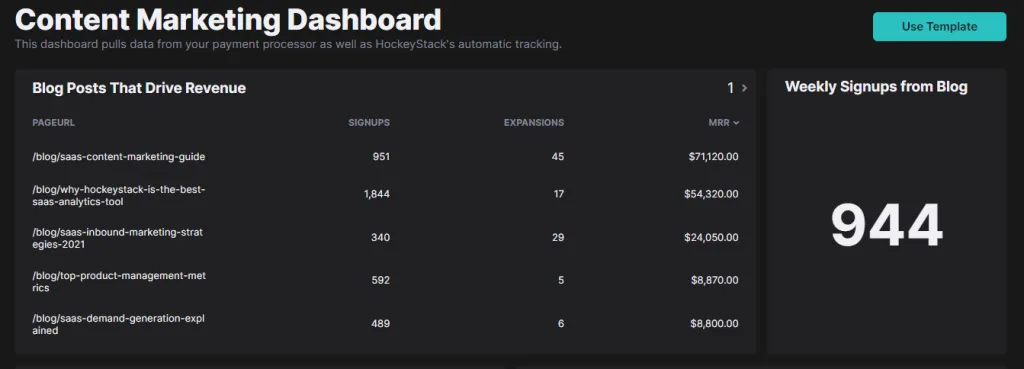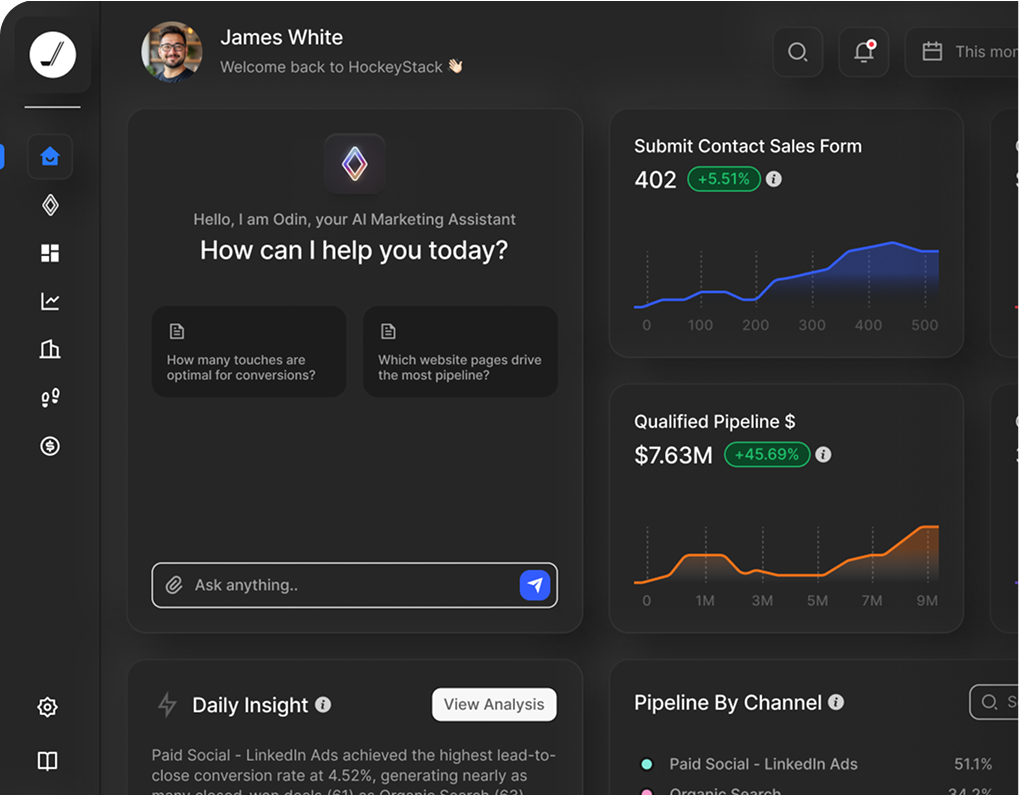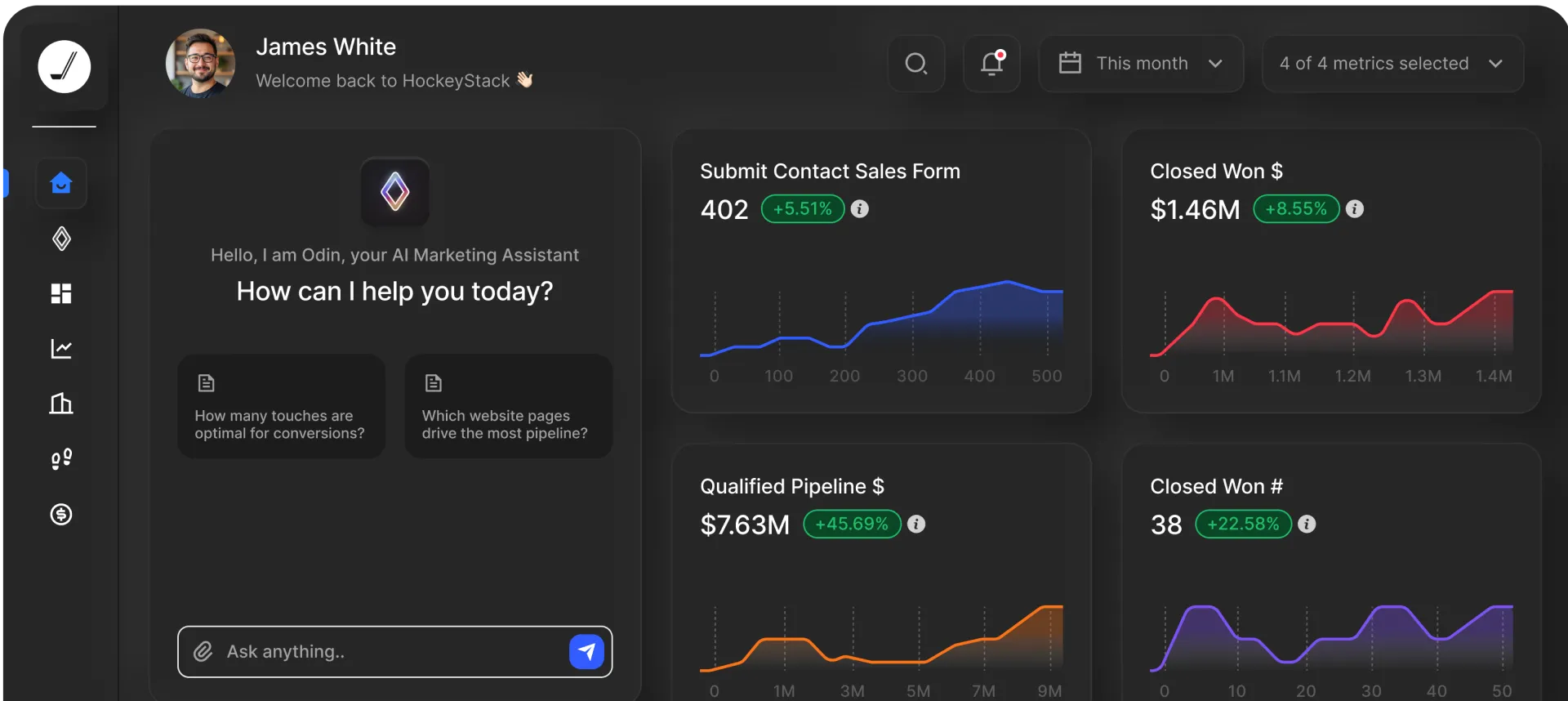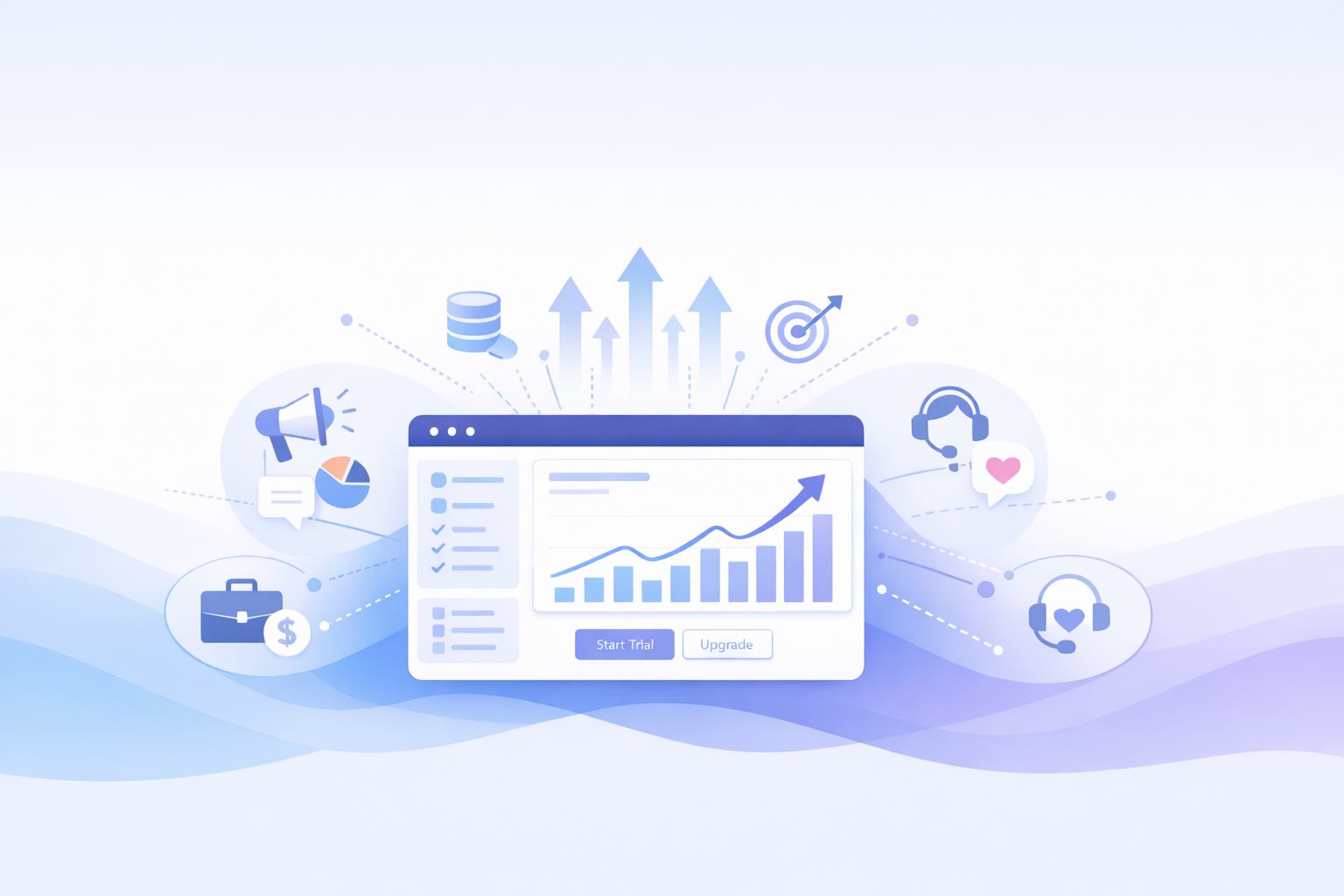Understanding SaaS Marketing Analytics: How to Make Every Touchpoint Count

Understanding SaaS Marketing Analytics: How to Make Every Touchpoint Count

Modern SaaS marketers are drowning in data, but let’s be real — most of it is scattered across a dozen platforms, making it nearly impossible to get a clear view of what’s actually working.
Tracking all the different CRM platforms, ad tools, and email systems often feels like a wild goose chase, with no concrete way to piece it all together.
Add to that the ongoing struggle with revenue attribution and understanding the real value of each touchpoint, and it's easy to see why proving ROI and planning budgets become serious pain points.
This fragmented data, confusing reports, and shaky attribution are killing your ROI, and we’re not here to sugarcoat it — it’s a mess. But it doesn’t have to stay that way.
This guide cuts through the noise and shows you how to make every touchpoint count. We're not here to add more data to your plate, but to help you start using the data you already have properly.
How Would You Define SaaS Marketing Analytics?
Ask a hundred marketers, and you’ll probably get a hundred different takes on what marketing analytics means.
But here’s how we define it at HockeyStack:
Marketing analytics is the process of compiling, managing, and analyzing marketing data to assess performance, optimize campaign strategies, and make data-driven decisions.
In SaaS marketing, these insights help businesses understand customer behaviors, improve acquisition and retention strategies, and ultimately increase MRR and ARR.
Types of Analytics that Can Be Used in SaaS Marketing
SaaS marketing relies on different types of analytics to get a full picture of what's working and what's not.
Below, we’ll break down the main types of marketing analytics SaaS companies should be using to improve their marketing strategies:
Descriptive Analytics
Descriptive analytics answers the question of what happened.
This analytics type provides a comprehensive summary of past events and trends, and helps you spot patterns and anomalies in your data.
In SaaS marketing, descriptive analytics typically covers:
- Sales reports: Looking at revenue, new sign-ups, and how many customers you're losing.
- Website traffic: Seeing how people use your site, which pages they visit, and bounce rates.
- Customer information: Understanding user profiles, preferences, and behaviors.
- Social media activity: Tracking likes, shares, comments, and follower growth.
You can use descriptive analytics to set benchmarks, see how you're progressing toward goals, and get a solid grasp of your current marketing situation.
PRO TIP 💡: With HockeyStack, you can connect to various marketing tools (CRM, ad platforms, social media, etc.) to get a more comprehensive view of your marketing performance, including sales, website traffic, customer information, and social media activity. Tracking key metrics, spotting trends, and benchmarking performance over time has never been easier.
Here is an example of what you can get:

Diagnostic Analytics
Diagnostic analytics helps answer the question of why something happened.
It digs into the data to find out the reasons behind trends, helping SaaS companies understand what caused certain successes or problems in the first place.
You can use this analysis to find the factors that influence performance, such as user behavior, market conditions, or product issues.
It’s commonly used for activities like A/B testing, where companies test different marketing or product strategies to determine what drives better results.
Other examples include customer satisfaction surveys that help diagnose why users are happy or dissatisfied and churn analysis to understand why customers are leaving.
PRO TIP 💡: HockeyStack's cohort analysis feature allows you to dig deeper into data and understand why certain trends are happening. For example, you can analyze churn by cohorts to find specific groups that are more likely to churn and understand the reasons behind it.
Predictive Analytics
Predictive analytics uses historical data to predict future outcomes, answering the question of what is likely to happen.
With statistical models and machine learning techniques, SaaS companies can anticipate customer behavior, market trends, and even marketing campaign performances.
It’s key for planning ahead—whether that’s finding high-risk users that might churn soon, forecasting sales based on past performances, or helping companies target the right people for upcoming campaigns.
PRO TIP 💡: HockeyStack uses statistical algorithms like marketing mix modeling and predictive analytics to understand historical performance better and to accurately predict future performances.

Prescriptive Analytics
Prescriptive analytics answers the question of what we should do.
It goes a step further than predictive analytics by not only forecasting what might happen, but also recommending actions to achieve the best possible outcomes.
It uses data analysis and predictive models to recommend specific actions that can help SaaS companies get the best results. Whether it’s fine-tuning marketing strategies, setting optimal prices, or improving product features, prescriptive analytics helps businesses make smarter decisions.
Common use cases include building personalized marketing campaigns for specific customer segments, inventory optimization to avoid overstocking or shortages, and developing pricing strategies that maximize profits based on demand.
PRO TIP 💡: HockeyStack’s advanced multi-touch attribution models provide a comprehensive view of how each marketing channel contributes to your revenue. With multi-touch attribution, you can accurately track customer interactions across their entire journey, from the first impression to the final conversion. This way, you’ll know which touchpoints—such as ads, emails, or social media—have the greatest impact on conversions.

Social Media Analytics
Social media analytics focuses on gathering and analyzing performance data from platforms like Twitter, LinkedIn, and Instagram to see how well your social marketing strategies are working.
It provides insights into key metrics such as engagement rate, follower growth, and brand mentions, so SaaS companies can easily track the reach and impact of their social media presence.
It’s a great way to see what content your audience likes, when to post for the most engagement, and how your social media presence supports bigger marketing goals.
PRO TIP 💡: HockeyStack can integrate with your social media platforms to provide insights into ad campaign performance, and ad spend to conversions to the rest of your data. You can use it to easily measure the impact of your social media advertising efforts.
Here is an example of what you can get when you connect HockeyStack and LinkedIn Ads.

Web Analytics
B2B web analytics involves analyzing your website data to understand how users interact with your site and to track key metrics like user behavior, conversions, and traffic sources.
SaaS companies can examine this data to better understand their website performance and see which areas they can optimize and A/B test to try and lift conversions.
Common tools for web analytics include Google Analytics, which provides detailed reports on visitor activity. Or, a better Google Analytics alternative would be a modern customer journey analytics and attribution platform like HockeyStack.
PRO TIP 💡: You can use HockeyStack to monitor and track your most important website metrics like traffic sources, page views, bounce rate, and user behavior in real-time. With this type of web analytics, you’ll have a clearer picture of how users interact with your website and see which areas need to be optimized for conversions.
Email Marketing Analytics
Email marketing analytics helps you track how well your email campaigns are doing by looking at metrics like open rates, click-through rates, and conversion rates.
The data shows whether your emails are reaching the right people and if your content is persuasive enough to get them to take action.
You can also monitor email deliverability to make sure your emails are actually landing in their primary inbox – not promotions, or worse, spam.
PRO TIP 💡: HockeyStack’s email software integrations make it easy for you to connect email marketing and lead gen activities with the rest of your data. You’ll get real-time insights into how well your emails campaigns are performing, which emails drive the most engagement, and which customer segments are most responsive.
Product Analytics
Product analytics shows how users interact with your product by investigating customer behavior and product usage data. Common metrics include feature adoption rates, user retention, and customer feedback.
This analysis is essential for improving product-market fit and customer satisfaction, as SaaS businesses can use the insights to refine features based on real user feedback and behavior.
3 Best Practices for Making Every Touchpoint Count
To make sure every interaction with your customers adds value and brings them closer to a conversion, it’s important to approach each touchpoint strategically.
Here's how you can make every touchpoint count:
Mapping the Customer Journey
First, you need to identify all the possible touchpoints—whether it's a visit to your website, a social media interaction, or an email click.
Each of these touchpoints provides an opportunity to shape their experience. And using analytics tools—like HockeyStack—you can track customer behavior across these channels in real-time.
With this granular data, you can get more than just surface-level personalization.
For example, if a customer frequently interacts with product pages but hasn’t made a purchase, you can adjust your messaging or offer specific promotions to re-engage them.
The goal is to ensure each touchpoint isn’t just an isolated interaction but part of a cohesive, data-driven strategy that meets your customers where they are and nudges them forward.
Attribution Modeling
Attribution modeling helps you figure out how each touchpoint in your customer’s journey contributes to a conversion.
Different models—like last-touch, first-touch, linear, and time-decay—give credit to different interactions. Last-touch focuses on the final interaction before a sale, while linear spreads the credit equally across all touchpoints.
The key is to pick the model that fits your business goals and how complex your customer journey is.
If your customers engage with your brand multiple times before converting, a time-decay model might make more sense since it gives more credit to later interactions.
Once you’ve chosen the right model, you can use the data to see which channels and campaigns are really driving results.
Data Visualization and Reporting
You can use visuals like charts, graphs, and dashboards to simplify complex data and make it more digestible. These visualizations help tell the story behind the numbers, giving your stakeholders a clear view of the big picture.
Tools like HockeyStack offer customizable dashboards, so you can personalize the layout and focus on what matters most to your business.
When presenting these reports, it’s important to call out the most important insights and offer recommendations that are easy to act on.
Common Marketing Analytics Challenges
While marketing analytics offers some big advantages, it also comes with its own set of challenges.
Below, we’ll go over some of the biggest ones SaaS companies run into:
Tracking the Right Metrics
With so much data available, it’s easy for SaaS companies to fall into the trap of focusing on vanity metrics—such as likes, shares, or page views—that offer little actionable insight.
The best practice is to find key metrics that directly impact growth, which usually include customer acquisition cost (CAC), lifetime value (LTV), or conversion rates.
Data Scattered Across Different Platforms
With marketing data often spread across email campaigns, social media, paid ads, and CRM systems, gathering and centralizing this data can be complex.
Without proper integration, marketers are left with bits and pieces of information, making it tough to get a full picture of how their campaigns are doing.
That’s why companies should invest in SaaS tools that unify data sources into a centralized dashboard where you can perform real-time analysis.
Understanding the Metrics and How to Analyze Them
While the data itself might be readily available, interpreting it correctly requires a deeper understanding of what each metric represents and how it relates to the broader business goals.
For example, you should know how customer acquisition cost (CAC) compares to customer lifetime value (CLTV) to see if your campaigns are profitable.
And it’s not just about having the numbers—companies need to know how to spot trends and patterns that can guide their next steps.
Limited Visualizations
Even though the data is technically there, basic charts like bars and lines don’t always show the full story.
Without advanced visual tools, it’s harder to spot important patterns that could impact decision-making. This can also make it tough to explain findings to others or act quickly on insights.
More advanced visualizations, like heat maps or funnel analysis, often give a much clearer picture of how campaigns are performing and how customers behave.
Lack of Automation
When there’s no automation in analytics, SaaS companies end up wasting a ton of time on manual tasks. And manually analyzing data from various platforms is not only time-consuming – it’s also prone to human error.
Marketers end up spending valuable hours compiling reports, running analyses, and creating dashboards, leaving little time for strategy and optimization.
How HockeyStack Can Help
If you’re looking for a way to overcome the challenges we discussed above, HockeyStack may be the perfect fit.
Here’s a closer look at how HockeyStack can help:
Clear Picture of the Customer Journey
HockeyStack integrates seamlessly with a wide range of platforms like CRMs (HubSpot, Salesforce), ad platforms, email marketing tools, and other key data sources to provide a centralized view of your entire buyer journey.
You can pull data from multiple sources to centralize scattered information into one platform, which also makes it easier to track and analyze each touchpoint—from the first interaction to closed deals.
Insights That Actually Drive Action
HockeyStack doesn't just gather data—it transforms it into actionable insights that your team can actually use when optimizing strategies and making decisions.
Through our customizable dashboards and reports, you can track key performance indicators like LTV (customer lifetime value), MRR (monthly recurring revenue), and churn rate with precision.
With advanced features like multi-touch attribution and funnel tracking, HockeyStack goes a step further and shows you how each marketing action impacts these metrics.
Attribution Made Simple
HockeyStack simplifies attribution by providing a complete view of how every marketing channel contributes to revenue.
Unlike traditional last-touch models, HockeyStack’s advanced multi-touch attribution distributes credit across all customer touchpoints—from the initial interaction to the final conversion. This holistic approach lets you see the real impact of each channel and campaign.
Data at Your Fingertips
HockeyStack makes it easy to cut through the noise by giving you access to the data that really matters.
You can prioritize key metrics such as customer lifetime value, revenue, and conversion rates, and stay focused on what truly drives growth.
What’s more, you can create custom reports and dashboards that cater to your company’s specific needs, so you can visualize only the data that’s relevant to your goals. This makes it much easier to go from analysis to action without getting stuck in data overload.
Easy Integration, Quick Results
HockeyStack is built with ease and speed in mind, especially for SaaS marketers.
It integrates seamlessly with your existing tools—whether it’s a CRM, email marketing platform, or ad management system—without the need for complex setup or a team of developers.
This means you can start gathering insights and making data-driven decisions in no time.
Optimize Your SaaS Marketing Strategy with HockeyStack
HockeyStack simplifies the chaos of B2B SaaS analytics, giving you clear, actionable insights when you need them most.
If you’re tired of juggling multiple analytics tools, HockeyStack brings everything together—offering a clear, all-in-one view of your marketing and product data.
With features like user behavior tracking, session recordings, and detailed event tracking, HockeyStack helps you understand your customer base and fine-tune strategies and campaigns.
With HockeyStack, you can:
- Monitor user behavior in real-time to see where they get stuck and how they interact with your product, so you can quickly spot and fix problem areas.
- Track at-risk customers by analyzing their sessions and understanding what leads them to churn, giving you the opportunity to act before it’s too late.
- Deep analysis of your marketing performance using custom funnels, automated insights, and conversion goals to see exactly which campaigns have the most impact.
- Simplify decision-making with easy-to-use dashboards and a no-code setup, so you can get powerful data without the headache of complex configurations.
And this is just the tip of the iceberg.
HockeyStack takes the guesswork out of B2B SaaS marketing analytics. If you’re ready for data-driven insights that actually make a difference, book a demo today.
FAQs
Why Is marketing analytics so important for SaaS?
Marketing analytics is particularly important for SaaS companies where there is a constant battle with high user acquisition costs and churn.
So, here are some of the main reasons why SaaS companies should pay attention to marketing analytics:
- Optimizing the subscription-based model: Most SaaS businesses rely on recurring revenue, which means they should constantly be optimizing their retention strategies. Marketing analytics helps determine the factors that influence acquisition, subscription renewals, and churn, so companies can fine-tune their offer and pricing strategies.
- Maximizing Customer Lifetime Value (CLTV): Analytics helps SaaS businesses accurately calculate and predict CLTV. With the right insights, the company can plan resources more effectively, focus on high-value customer segments, and tailor retention efforts.
- Drives product-led growth: Many SaaS companies employ a product-led growth strategy, where the product itself drives acquisition and retention. Tracking product usage, user behavior, and customer pain points through analytics helps SaaS companies refine onboarding processes and optimize the product experience.
- Achieving scalable growth: Marketing analytics provides the metrics and KPIs you need in order to find scalable acquisition channels and plan marketing spend.
- Refining your customer segmentation approach: You can use analytics data to improve your customer segmentation approach based on behavior data, particular user needs, and customer engagement levels. This way, you improve targeting and increase conversion rates across different user groups.
What are the benefits of marketing analytics for SaaS
Marketing analytics offers a range of benefits that can help SaaS companies drive business growth and improve customer retention.
Some of the main ones include:
Companies can improve customer acquisition strategies
Marketing analytics helps SaaS companies improve acquisition strategies with insights into which channels and audiences are the most effective.
Instead of relying on assumptions, businesses can see precisely which channels and campaigns are working best and adjust their budget accordingly.
Helps optimize customer retention
You can analyze data such as engagement frequency, feature usage, and customer support interactions, to quickly determine when customers are most likely to leave and intervene proactively.
Using this data, SaaS companies can design retention strategies tailored to individual user needs, offering personalized content, support, or similar incentives that keep them satisfied.
It also shows which product features keep people coming back, so you can focus on what really matters for long-term retention.
Overall better marketing ROI
Marketing analytics shows which marketing efforts—like paid ads or content—are driving results and which aren’t, so the business can focus its budget on what’s actually working.
This cuts down on wasted spending and makes every dollar count.
Analytics also give insights into key metrics like customer acquisition cost (CAC) and customer lifetime value (LTV), making it easier to target the most profitable customers.
Which departments within a SaaS company should prioritize marketing analytics?
Marketing analytics is a valuable tool for a wide range of individuals within SaaS companies.
Here are some key roles that should be involved:
- Marketing teams: Marketers are at the forefront of using analytics to measure campaign performance, track customer behavior, and optimize marketing strategies.
- Marketing leaders: Marketing leaders rely on analytics to make smart, big-picture decisions that drive company growth.
- Product managers: Product managers can use analytics to understand product usage, spot common pain points, and inform product development decisions.
- Sales teams: Sales reps can rely on analytics to track number of leads, find new ones, better understand customer needs, and personalize their sales pitches to specific user segments.
- Customer success managers: Customer success teams use analytics to track customer satisfaction, spot at-risk customers, and proactively address their needs.
- Data analysts: Data analysts play a crucial role in interpreting marketing analytics, turning raw data into insights that inform decision-making across all departments.
What are the key SaaS marketing metrics you should be tracking to understand your performance?
Tracking the right metrics is essential for measuring the success of your SaaS marketing efforts.
Here are some of the most important metrics that provide insights into your performance and help guide your strategy:
Customer Acquisition Metrics
- Cost per acquisition (CPA): CPA measures the total cost spent on acquiring a single customer through marketing efforts.
- Customer acquisition cost (CAC): CAC calculates the total amount of money your business spends to acquire a new customer.
- Lead-to-customer conversion rate: This metric tracks how effectively leads convert into paying customers.
- Marketing qualified lead (MQL) to customer conversion rate: Measures the percentage of MQLs that turn into actual customers.
Customer Retention Metrics
- Customer churn rate: Customer churn rate shows the percentage of customers who stop using your product over a specific period.
- Customer lifetime value (CLV): CLV shows the total revenue an organization can expect from a single customer over the course of their business relationship.
- Lifetime value (LTV): LTV calculates the projected value a customer will bring to the business throughout their lifecycle.
- Customer retention rate: Tracks the percentage of customers who continue using your service over a specific period.
- Net promoter score (NPS): NPS evaluates customer loyalty by measuring how likely customers are to recommend your service to others.
- Average revenue per user (ARPU): ARPU calculates the average revenue a single user brings over a specific period.
Marketing Campaign Metrics
- Open rate: Open rate shows how many subscribers open your emails.
- Click-through rate (CTR): CTR tracks the percentage of recipients who click on a link within your campaign.
- Conversion rate: The conversion rate measures the percentage of users who complete a desired action, such as signing up for a demo or making a purchase.
- Return on investment (ROI): ROI shows you how profitable your marketing campaign is by comparing the generated revenue to the cost of running the campaign.
Social Media Metrics
- Follower Growth: Follower growth measures the rate at which your social media audience expands over time.
- Engagement Rate: The engagement rate tracks how actively your audience interacts with your content through likes, comments, shares, and other forms of interaction.
- Social Media Traffic: Social media traffic measures the number of visitors driven to your website from social platforms.
What is the top marketing analytics software for SaaS companies?
The right marketing analytics software can make all the difference in understanding your data and making better decisions.
Here are some of the top tools that SaaS companies can use to drive growth:
- HockeyStack: HockeyStack is a no-code analytics and attribution platform designed for B2B SaaS companies, offering comprehensive, cookieless tracking to analyze user behavior across websites and apps. By integrating marketing, revenue, sales, and product data, it provides a holistic view of customer journeys, enabling teams to optimize performance and improve tracking accuracy by up to 40%.
- Mixpanel: Mixpanel is a powerful product analytics platform that companies can use to track user behavior and engagement within their digital products.
- Google Analytics 4: Google Analytics 4 is the latest version of Google's analytics platform and it comes with advanced event-based tracking, machine learning technology, and cross-platform insights.
- Amplitude: Amplitude is a leading analytics platform focused on product intelligence, helping SaaS companies understand how customers interact with their products and what features they use the most.
- HubSpot: HubSpot is a comprehensive inbound marketing and sales platform that provides tools for managing content, automating marketing campaigns, and tracking lead generation.
- Salesforce Marketing Cloud: Salesforce Marketing Cloud is another robust platform for managing and automating marketing across multiple digital marketing channels, including email, social media, and advertising.
- Adobe Analytics: Adobe Analytics is a sophisticated analytics tool that companies use to get insights into customer behavior across touchpoints, with also advanced segmentation features to create personalized user experiences.
- Tableau: Tableau is another popular data visualization platform that helps businesses transform complex data into easy-to-understand, interactive dashboards.
- Power BI: Microsoft Power BI is business intelligence software that SaaS companies can use to build detailed reports from their data and get an easier way to extract insights.
- Looker: Looker is a modern data analytics platform that businesses can rely on to analyze and visualize data with powerful, customizable dashboards.
6sense vs. Demandbase: Head-to-Head Comparison (+ Better Options)
Detailed analysis of 6sense vs Demandbase: features, pricing, and limitations. Plus, explore modern alternatives that might better fit your needs.


Ready to see HockeyStack in action?
HockeyStack turns all of your online and offline GTM data into visual buyer journeys and dashboards, AI-powered recommendations, and the industry’s best-performing account and lead scoring.

Ready to See HockeyStack in Action?
HockeyStack turns all of your online and offline GTM data into visual buyer journeys and dashboards, AI-powered recommendations, and the industry’s best-performing account and lead scoring.




